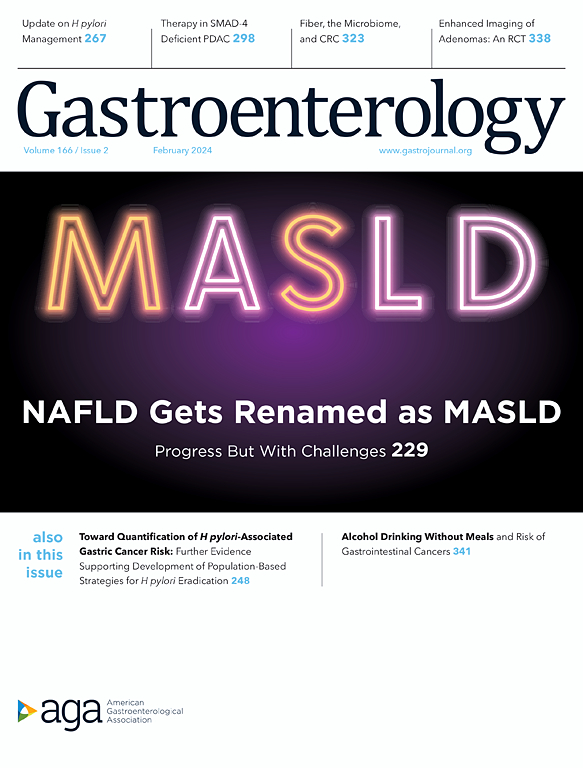非达索霉素通过抑制血小板衍生生长因子受体β和糖原合成酶激酶-3 β来降低肠成纤维细胞中胶原蛋白的表达。
IF 25.7
1区 医学
Q1 GASTROENTEROLOGY & HEPATOLOGY
引用次数: 0
摘要
约30-50%的克罗恩病(CD)患者最终发展为肠道狭窄,肠道纤维化是其中的主要组成部分。目前还没有批准的治疗纤维化狭窄的药物。方法采用10x Genomics Visium spatial RNA测序和高通量筛选(high-throughput screening, HTS)技术发现肠道纤维化的分子靶点。使用狭窄性CD (CDS)患者来源的原代肠成纤维细胞(CD- hfs)、CDS患者来源的血清外泌体(CDSE)、手术切除的新鲜全层回肠组织和肠道纤维化小鼠模型。结果空间RNA测序发现,血小板衍生生长因子受体β (PDGFRB)在CDS患者的纤维化回肠组织中过表达。PDGFRB siRNA抑制cdse处理的cd - hif中胶原的表达。HTS发现PDGFRB抑制剂抑制cdse处理的cd - hif中胶原启动子活性。机器学习算法和分子对接预测PDGFR作为非达霉素的靶标。Fidaxomicin是fda批准的治疗艰难梭菌感染的药物,可抑制cdse治疗的cd - hfs和CDS患者来源的回肠组织中胶原和PDGFRB mRNA的表达。cdse处理的cd - hfs增加了PDGFRβ和糖原合成酶激酶3α/β (GSK3α/β)的磷酸化。非达索霉素抑制cdse处理的cd - hfs中PDGFRβ磷酸化、PDGFRB mRNA表达和GSK3β磷酸化。血小板衍生生长因子- bb (PDGF-BB)和胰岛素样生长因子1 (IGF-1)分别是PDGFRβ配体和GSK3α/β磷酸化激活剂,可减弱非达索霉素的抗纤维化作用。在SAMP1/YitFc小鼠中,口服非达索霉素可抑制回肠纤维化和回肠PDGFRB mRNA表达以及PDGFRB β和GSK3β磷酸化,而PDGFRB和Gsk3b的过表达可消除PDGFRB和GSK3β磷酸化。结论非达霉素通过降低肠成纤维细胞PDGFRβ磷酸化表达、GSK3β磷酸化表达和胶原蛋白表达抑制肠纤维化。本文章由计算机程序翻译,如有差异,请以英文原文为准。
Fidaxomicin reduces collagen expression in intestinal fibroblasts via platelet-derived growth factor receptor beta and glycogen synthase kinase-3 beta inhibition.
Introduction
About 30-50% of patients with Crohn’s disease (CD) eventually develop intestinal strictures, with intestinal fibrosis being a major component of them. There is currently no approved medication to treat fibrotic strictures.Methods
10X Genomics Visium spatial RNA sequencing and high-throughput screening (HTS) were used to discover the molecular targets of intestinal fibrosis. Stricturing CD (CDS) patient-derived primary intestinal fibroblasts (CD-HIFs), CDS patient-derived serum exosomes (CDSE), fresh surgically resected whole-thickness ileal tissues, and mouse models of intestinal fibrosis were used.Results
Spatial RNA sequencing found overexpression of platelet-derived growth factor receptor beta (PDGFRB) in the fibrotic ileal tissues of CDS patients. PDGFRB siRNA inhibited collagen expression in the CDSE-treated CD-HIFs. HTS identified PDGFRB inhibitors that suppressed collagen promoter activity in CDSE-treated CD-HIFs. A machine learning algorithm and molecular docking predicted PDGFR as a target for fidaxomicin. Fidaxomicin, an FDA-approved drug for C. difficile infection, inhibited collagen and PDGFRB mRNA expression in CDSE-treated CD-HIFs and CDS patient-derived ileal tissues. CDSE-treated CD-HIFs had increased PDGFRβ and glycogen synthase kinase-3 alpha/beta (GSK3α/β) phosphorylation. Fidaxomicin inhibited PDGFRβ phosphorylation, PDGFRB mRNA expression, and GSK3β phosphorylation in CDSE-treated CD-HIFs. The anti-fibrogenic effect of fidaxomicin was attenuated by platelet-derived growth factor-BB (PDGF-BB) and insulin-like growth factor 1 (IGF-1), which are a PDGFRβ ligand and a GSK3α/β phosphorylation activator, respectively. In the SAMP1/YitFc mice, oral fidaxomicin treatment inhibited ileal fibrosis and ileal PDGFRB mRNA expression and PDGFRβ and GSK3β phosphorylation, which were abolished by Pdgfrb and Gsk3b overexpression.Conclusions
Fidaxomicin inhibits intestinal fibrosis by reducing PDGFRβ phosphorylation and expression, GSK3β phosphorylation, and collagen expression in intestinal fibroblasts.求助全文
通过发布文献求助,成功后即可免费获取论文全文。
去求助
来源期刊

Gastroenterology
医学-胃肠肝病学
CiteScore
45.60
自引率
2.40%
发文量
4366
审稿时长
26 days
期刊介绍:
Gastroenterology is the most prominent journal in the field of gastrointestinal disease. It is the flagship journal of the American Gastroenterological Association and delivers authoritative coverage of clinical, translational, and basic studies of all aspects of the digestive system, including the liver and pancreas, as well as nutrition.
Some regular features of Gastroenterology include original research studies by leading authorities, comprehensive reviews and perspectives on important topics in adult and pediatric gastroenterology and hepatology. The journal also includes features such as editorials, correspondence, and commentaries, as well as special sections like "Mentoring, Education and Training Corner," "Diversity, Equity and Inclusion in GI," "Gastro Digest," "Gastro Curbside Consult," and "Gastro Grand Rounds."
Gastroenterology also provides digital media materials such as videos and "GI Rapid Reel" animations. It is abstracted and indexed in various databases including Scopus, Biological Abstracts, Current Contents, Embase, Nutrition Abstracts, Chemical Abstracts, Current Awareness in Biological Sciences, PubMed/Medline, and the Science Citation Index.
 求助内容:
求助内容: 应助结果提醒方式:
应助结果提醒方式:


